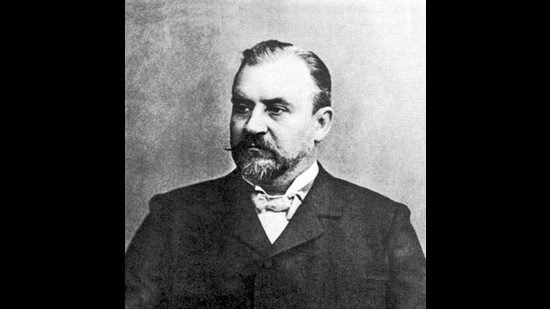It was while analysing the chemical compounds in coal tar that Russian researcher Constantin Fahlberg of Johns Hopkins University discovered the world’s first artificial sweetener.
After working in his lab all day, Fahlberg grabbed a piece of bread at dinner and found that it tasted sweet. He rushed back to his beakers and, the story goes, tasted every ingredient he had worked with. It turned out that benzoic sulfimide was the sweetener. And so, in 1879, saccharin was born.
Fahlberg took its name from the Latin word for sugar (saccharum), which in turn has roots in the Sanskrit sharkara. He patented the compound in 1885, and soon began the first factory to produce saccharin, in Germany.
Because the body does not metabolise artificial sweeteners, they pass right through, and are therefore among the few things that are truly zero-calorie. As such, saccharin caught on with diabetics as a sugar substitute. It began to be used as a sweetener in the pharmaceutical industry. And since it was 300 times sweeter than sugar, companies such as Coca-Cola began using it to reduce costs.

But was benzoic sulfimide safe to consume? The question plagued chemist and food safety activist Harvey Wiley. As the processed foods segment boomed in the US — we’ve talked recently about breakfast cereals, chocolate bars and jams, all of which were being mass-produced for the first time in this period — Wiley began to campaign for uniform standards and greater transparency. It was his efforts that led to the formation of the US Food and Drug Administration (FDA) in 1906.
But even then-President Theodore Roosevelt, who signed the FDA Act into law, would not hear ill of saccharin. He was taking it himself, on doctor’s orders. “Anybody who says saccharin is injurious to health is an idiot,” the portly gentleman reportedly said.
Over the next 80 years, a range of chemical sweeteners was developed: aspartame, acesulfame potassium (Ace-K), sucralose.
All artificial sweeteners have some things in common: They are not found in nature, but are manufactured in labs. They are several hundred times sweeter than sugar. They have zero calories.
But was benzoic sulfimide safe to consume? The question plagued chemist and food safety activist Harvey Wiley. As the processed foods segment boomed in the US — we’ve talked recently about breakfast cereals, chocolate bars and jams, all of which were being mass-produced for the first time in this period — Wiley began to campaign for uniform standards and greater transparency. It was his efforts that led to the formation of the US Food and Drug Administration (FDA) in 1906.
But even then-President Theodore Roosevelt, who signed the FDA Act into law, would not hear ill of saccharin. He was taking it himself, on doctor’s orders. “Anybody who says saccharin is injurious to health is an idiot,” the portly gentleman reportedly said.
Over the next 80 years, a range of chemical sweeteners was developed: aspartame, acesulfame potassium (Ace-K), sucralose.
All artificial sweeteners have some things in common: They are not found in nature, but are manufactured in labs. They are several hundred times sweeter than sugar. They have zero calories.
Through the decades there has been talk of links to cancer, obesity, but no clear evidence has been found in human trials. While there has been controversy over the possible impact of long-term use, governments around the world have approved most non-nutritive sweeteners, with the rider of some limits for safe consumption.
New studies do suggest, however, that artificial sweeteners such as saccharin, sucralose and aspartame can negatively impact the gut microbiome.
An alternative emerged in the 1990s, when non-caloric sweeteners began to be extracted from plants such as stevia and monk fruit. There are two issues with this class of sweeteners: The first is that many leave a bitter aftertaste. The second issue is a far more significant one that affects all artificial sweeteners: the problem of retail packaging.
You’d need just a few grains of any of these sweeteners for a mug of coffee. So, to make them easy to use, they’re packaged in sachets where most of the mass comes from bulking agents such as maltodextrin — a type of carbohydrate that not only has the same calories as sugar (1 tsp = 4 calories) but also has a higher glycemic index (105, against sugar’s 65)!
Will there ever be a better answer? The next big thing in sugar substitutes is likely to be sugar alcohols (erythritol, maltitol, xylitol, etc), which are naturally occurring substances in plants and vegetables. Extracting them for mass production is expensive, though. Sugar alcohols are also less sweet than sugar. They contain fewer calories, but not zero. And too much of a sugar alcohol can cause bloating and gastric distress.
For now, the best thing to do is assess the impact of the sweeteners you consume on your body. There’s a simple test: How do you feel after ingesting a product? If the answer is, “not great, actually”, switch to another one. After all, the market is full of big businesses trying hard to answer the age-old question of how to have your cake and eat it too.
(To reach Swetha Sivakumar with questions or feedback, email [email protected])
Enjoy unlimited digital access with HT Premium
Subscribe Now to continue reading

Stay connected with us on social media platform for instant update click here to join our Twitter, & Facebook
We are now on Telegram. Click here to join our channel (@TechiUpdate) and stay updated with the latest Technology headlines.
For all the latest Art-Culture News Click Here
